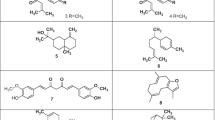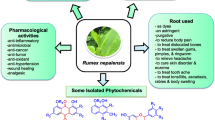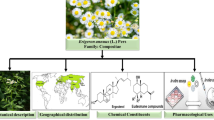Abstract
Roscoea purpurea Sm. (Family: Zingiberaceae) is a medicinally important herb endemic to the Himalayan region distributed from Himachal Pradesh to Arunachal Pradesh in India. The tuberous rhizomes of the species are used in traditional formulations as a tonic for seminal debility and many other diseases. The rhizomes are used as an ingredient of a popular Ayurvedic polyherbal formulation “Chyawanprash.” The species has been reported as a rich source of various nutritive constituents, minerals, phenolics, terpenoids, and carotenoids. Scientific studies showed that the rhizomes possess various pharmacological properties such as immunomodulatory, hepatoprotective, antidiabetic, hypolipidemic, anticancer, antioxidant, antibacterial, and antifungal effects. This chapter mainly focused on the scientific progress of the species related to nutritional and phytochemical composition, and pharmacological activities, with its potential in the nutraceutical market. However, research on the validation of traditional uses through pharmacological activities and clinical studies on humans is insufficient to support the species for ingredients of the dietary health supplements.
Similar content being viewed by others
Abbreviations
- ABTS:
-
2,2′-azino-bis(3-ethylbenzothiazoline-6-sulfonic acid) radical scavenging assay
- ALT:
-
Alanine transaminase
- AST:
-
Aspartate transferase
- BHT:
-
Butylated hydroxytoluene
- cpDNA:
-
Chloroplast DNA
- DPPH:
-
2,2 Diphenyl 1 picrylhydrazyl radical scavenging assay
- ELSD:
-
Evaporative light scattering detector
- GAE:
-
Gallic acid equivalent
- GC/MS:
-
Gas chromatography–mass spectrometry
- HCT-116:
-
Human colorectal carcinoma cell line
- HDL:
-
High-density lipoprotein
- IC50:
-
Half maximal inhibitory concentration
- IHR:
-
Indian Himalayan Region
- ISSR:
-
Inter-simple sequence repeats
- LDL:
-
Low-density lipoprotein
- MBC:
-
Minimum bactericidal concentration
- MIC:
-
Minimum inhibitory concentration
- MTT:
-
3-(4,5-Dimethylthiazol-2-yl)-2,5-diphenyltetrazolium bromide assay
- NGS:
-
Next-generation sequencing
- NJ:
-
Neighbor joining
- nrDNA:
-
Nuclear ribosomal DNA
- QE:
-
Quercetin equivalents
- RP-HPLC:
-
Reverse phase High-performance liquid chromatography
- SRBC:
-
Sheep red blood cells
References
Kress WJ, Prince LM, Williams KJ (2002) The phylogeny and a new classification of the gingers (Zingiberaceae): evidence from molecular data. Amer J Bot 89:1682–1696
Chattopadhyay I, Biswas K, Bandyopadhyay U, Banerjee RK (2004) Turmeric and curcumin: Biological actions and medicinal applications. Curr Sci 87:44–53
Cowley J, Wilford R, Bream R, Lock M (2007) The genus Roscoea. Royal Botanic Gardens, Kew
Dhyani A, Bahuguna YM, Nautiyal BP, Chaturvedi P, Nautiyal MC (2021) Ecological features and traditional knowledge of Roscoea alpina Royle a medicinal plant in Himalaya. Indian J Tradit Knowl 20:167–173
Zhao JL, Zhong J, Fan YL, Xia YM, Li QJ (2017) A preliminary species-level phylogeny of the alpine ginger Roscoea: implications for speciation. J Syst Evol 55:215–224
Wilford R (1999) Roscoeas for the rock garden. Quarter Bull Alpine Garden Soc 67:93–101
Li DB, Ou XK, Zhao JL, Li QJ (2020) An ecological barrier between the Himalayas and the Hengduan Mountains maintains the disjunct distribution of Roscoea. J Biogeogr 47:326–341
Das VB (1994) Materia medica of tibetean medicine. Sai Satguru publication, Delhi, pp 130–131
Chinmay R, Kumari S, Dhar B, Mohanty RC, Dixit R, Padhi MM, Baby R (2011) Pharmacognostical and phytochemical studies of Roscoea procera (Kakoli) and Lilium Polyphyllum (Ksheerkakoli) in comparison with market samples. Pharm J 23:32–38
Balkrishna A, Srivastava A, Mishra RK, Patel SP, Vashistha RK, Singh A et al (2012) Astavarga plants-threatened medicinal herbs of the North-West Himalaya. Int J Med Arom Plants 2:661–676
Rawat S, Andola H, Giri L, Dhyani P, Jugran A, Bhatt ID, Rawal RS (2014) Assessment of nutritional and antioxidant potential of selected vitality strengthening Himalayan medicinal plants. Int J Food Prop 17:703–712
Wu D, Larsen K (1994) Zingiberaceae. retrieved 2011-10-01. In: Wu, Raven & Hong onwards. Flora of China. Science Press/Missouri Botanical Garden, Beijing/St. Louis
Mao AA, Bhaumik M (2007) Roscoea ngainoi (Zingiberaceae) sp. nov. from Manipur, India. Nord J Bot 25:299–302
Mohandass D, Zhao JL, Xia YM, Campbell MJ, Li QJ (2015) Increasing temperature causes flowering onset time changes of alpine ginger Roscoea in the Central Himalayas. J Asia Pac Biodivers 8:191–198
Ngamriabsakul C, Newman MF, Cronk QCB (2000) Phylogeny and disjunction in Roscoea (Zingiberaceae). Edinb J Bot 57:39–61
Zhao JL, Paudel BR, Yu XQ, Zhang J, Li QJ (2021) Speciation along the elevation gradient: divergence of Roscoea species within the south slope of the Himalayas. Mol Phylogenet Evol 164:107292
Cowley EJ (1982) A revision of Roscoea (Zingiberaceae). Kew Bull 36:747–777
Cowley J, Baker W (1994) Roscoea purpurea ‘red gurkha’: Zingiberaceae. Kew Mag 11:104–109
Wu D, Larsen K (2011) “Roscoea”, retrieved 2011-10-01. In: Wu Z, Raven PH, Hong D (eds) (onwards), Flora of China. Science Press/Missouri Botanical Garden, Beijing/St. Louis
Paudel BR, Shrestha M, Dyer AG, Zhu XF, Abdusalam A, Li QJ (2015) Out of Africa: evidence of the obligate mutualism between long corolla tubed plant and long-tongued fly in the Himalayas. Ecol Evol 5:5240–5251
Paudel BR, Burd M, Shrestha M, Dyer AG, Li QJ (2018) Reproductive isolation in alpine gingers: how do coexisting Roscoea (R. purpurea and R. tumjensis) conserve species integrity? Evolution 72:1840–1850
Singh G, Rawat GS (2011) Ethnomedicinal survey of Kedarnath wildlife sanctuary in Western Himalaya, India. Indian J Fundam Appl Life Sci 1:35–46
Kaur G, Gupta V, Kumar S, Singhal RG, Maithani M, Bansal P (2019) Compliance level of textual therapeutic usage of kakoli-containing formulations with ethnomedicinal survey and modern system of medicine. Imam J Appl Sci 4:62–68
Shah R (2006) Nature’s medicinal plants of Uttaranchal. Gyanodaya Prakashan, Nainital
Misra A, Srivastava S, Verma S, Rawat AKS (2015) Nutritional evaluation, antioxidant studies and quantification of poly phenolics, in Roscoea purpurea tubers. BMC Res Notes 8:1–7
Rana JC, Sharma BD, Jha BJ, Kumar M (2004) Cultivation of Hedychium spicatum (Kapoor Kachari), Valeriana wallichii and Roscoea purpurea in hill regions of India. Indian For 130:1008–1018
Sahu MS, Verma A, Mali PY, Rangari VD (2012) Isolation and characterization of bioactive compound from Roscoea procera Rhizomes. Bio Med 111:544–547
Kumari P, Joshi GC, Tewari LM (2011) Diversity and status of ethno-medicinal plants of Almora district in Uttarakhand, India. Int J Biodiv Conserv 3:298–326
Sahu RA, Itankar PR, Mishra RR, Maliye AN (2016) Pharmacological evaluation of Roscea procera (Kakoli) and Lilium polyphyllum (Kshirkakoli) extracts for immunomodulatory activity. Int J Pharmacogn Phytochem Res 8:1788–1794
Govindrajan R, Vinaykumar M, Pushpangadan P (2005) Antioxidant approach to disease management and the role of ‘Rasayana’ herb of Ayurveda. J Ethanopharmacol 99:165–178
Govindarajan R, Singh DP, Rawat AKS (2007) High-performance liquid chromatographic method for the quantification of phenolics in ‘Chyavanprash’ a potent Ayurvedic drug. J Pharm Biomed Anal 43:527–532
Rawat S, Acharya P, Bhutia PO, Pandey A, Kumar D, Joshi R, Bhatt ID (2023) Changes in nutritional, physicochemical, phytochemical composition and antioxidant potential of Mahonia nepalensis fruits during ripening. Int J Food Prop 26:1062–1078
Bhutia PO, Kewlani P, Pandey A, Rawat S, Bhatt ID (2021) Physico-chemical properties and nutritional composition of fruits of the wild Himalayan strawberry (Fragaria nubicola Lindle.) in different ripening stages. J Berry Res 11:481–496
Rawat S, Bhatt ID, Rawal RS, Nandi SK (2017) Geographical and environmental variation in chemical constituents and antioxidant properties in Roscoea procera wall. J Food Biochem 41:e12302
Srivastava S, Misra A, Kumar D, Srivastava A, Sood A, Rawat AKS (2015) Reversed-phase high-performance liquid chromatography-ultraviolet photodiode array detector validated simultaneous quantification of six bioactive phenolic acids in Roscoea purpurea tubers and their In vitro cytotoxic potential against various cell lines. Pharmacogn Mag 11:S488
Giri L, Belwal T, Bahukhandi A, Suyal R, Bhatt ID, Rawal RS, Nandi SK (2017) Oxidative DNA damage protective activity and antioxidant potential of Ashtvarga species growing in the Indian Himalayan Region. Ind Crop Prod 102:173–179
Miyazaki S, Devkota HP, Joshi KR, Watanabe T, Yahara S (2014) Chemical constituents from the aerial parts and rhizomes of Roscoea purpurea. Japan J Pharmacogn 68:99–100
Kaur G, Gupta V, Singhal RG, Rawal RK, Bansal P (2020) Isolation of catechins from Roscoea purpurea. J Young Pharm 12:389–391
Singamaneni V, Lone B, Singh J, Kumar P, Gairola S, Singh S, Gupta P (2021) Coronarin K and L: two novel labdane diterpenes from Roscoea purpurea: an ayurvedic crude drug. Front Chem 9:642073
Williams CA, Harborne JB (1977) The leaf flavonoids of the Zingiberales. Biochem Syst Ecol 5:221–229
Kaur G, Gupta V, Bansal P, Kumar S, Rawal RK, Singhal RG (2020) Isolation of lupenone (18-Lupen-3-one) from Roscoea purpurea root extract. Bangladesh J Medl Sci 19:692–696
Bag BG, Barai AC (2020) Self-assembly of naturally occurring stigmasterol in liquids yielding a fibrillar network and gel. RSC Adv 10:4755–4762
Raval SS, Mandavia MK, Sanghani JM, Mahatma MK, Golakiya BA (2015) Separation and identification of phytochemicals from Roscoea procera Wall.(Kakoli), an ingredient of Ashtavarga. Indian J Agric Biochem 28:143–149
Rawat S, Jugran AK, Bahukhandi A, Bahuguna A, Bhatt ID, Rawal RS, Dhar U (2016) Anti-oxidant and anti-microbial properties of some ethno-therapeutically important medicinal plants of Indian Himalayan. Region 3 Biotech 6:1–12
Kaur G, Gupta V, Singhal RG, Joshi MD, Rawal RK, Singh R, Bans P (2020) Isolation of chemical marker from Roscoea purpurea: first report. Human J 2:1–11
Bathla R, Sethi S, Prakash O, Punetha H, Pant AK, Batra M, Kumar M (2016) Phytochemical analysis, antioxidant and hepatoprotective activity of Roscoea purpurea, a Zingiberaceous herb collected from Kumaun hills of Uttarakhand. Asian J Tradit Med 11:141–152
Sahu MS, Mali PY, Waikar SB, Rangari VD (2011) Evaluation of immunomodulatory potential of ethanolic extract of Roscoea procera rhizomes in mice. J Pharm Bioallied Sci 2:346
Bairwa R, Basyal D, Srivastav B (2012) Study of antidiabetic and hypolipidemic activity of Roscoea purpurea (zingiberaceae). Int J Inst Pharma Life Sci 2:130–137
Jugran AK, Rawat S, Devkota HP, Bhatt ID, Rawal RS (2021) Diabetes and plant-derived natural products: from ethnopharmacological approaches to their potential for modern drug discovery and development. Phytother Res 35:223–245
Tewari VP, Tewari KC, Yadava BBL (1976) Study of Roscoea procera Wall. (Kakoli-Ksheerkakoli of Astavarga). Quart J Crude Drug Res 14:69–70
Das A (2008) Agro-techniques of selected medicinal plants. National Medicinal Plants Board, New Delhi
Bhatt ID, Prasad K, Rawat S, Rawal RS (2008) Evaluation of antioxidant phytochemical diversity in Hedychium spicatum: a high value medicinal plant of Himalaya. Pharmacogy Mag 4:202–205
Rawat S, Jugran AK, Bhatt ID, Rawal RS (2018) Influence of the growth phenophases on the phenolic composition and anti-oxidant properties of Roscoea procera Wall. in western Himalaya. J Food Sci Technol 55:578–585
Bhatt ID, Dauthal P, Rawat S, Gaira KS, Jugran A, Rawal RS, Dhar U (2012) Characterization of essential oil composition, phenolic content, and antioxidant properties in wild and planted individuals of Valeriana jatamansi Jones. Sci Hortic 136:61–68
Fischer AM, Gan S (2007) Nutrient remobilization during leaf senescence. Ann Rev Senescence Proc Plants 26:87–107
Govaerts R (2009) World checklist of selected plant families. Royal Botanic Gardens, Landon
Chen ZY (1987) The taxonomic significance of chromosome numbers in Zingiberaceae. In: Shui H, Tanaka R, Chen R, et al, Proceeding of the Sino-Japanese symposium on plant chromosomes, Beijing, pp 107–114
Chen ZY (1989) Evolutionary pattern in cytology and pollen structure of Asia Zingiberaceae. In: Holm-Nielsen LB, Nielsen IC, Balslev H (eds) Tropical forest: botanical dynamics, speciation and diversity. Aarhus University Academic Press, Carnwall, pp 185–191
Bhattacharyya R (1968) Systematic status of the family Zingiberaceae. Nucleus (Supplement Vol.): 39–41
Mahanty HK (1970) Cytological study of the Zingiberales with special reference to their taxonomy. Cytologia 35:13–49
Mehra PN, Sachdeva SK (1971) IOPB chromosome reports XXXIII. Taxon 20:609–614
Zhang D, Duan L, Zhou N (2014) Application of DNA barcoding in Roscoea (Zingiberaceae) and a primary discussion on taxonomic status of Roscoea cautleoides var. pubescens. Biochem Syst Ecol 52:14–19
Rawat S, Jugran AK, Bhatt ID, Rawal RS, Nandi SK (2016) Genetic diversity analysis in natural populations of Roscoea procera Wall. from West Himalaya, India. Brazil J Bot 39:621–630
Bag BG, Shankar Dash S, Roy A (2014) Study of antioxidant property of the rhizome extract of Roscoea purpurea Sm. (Kakoli) and its use in green synthesis of gold nanoparticles. Int J Res Chem Env 4:174–180
Basri AM, Taha H, Ahmad N (2017) A review on the pharmacological activities and phytochemicals of Alpinia officinarum (Galangal) extracts derived from bioassay-guided fractionation and isolation. Pharmacogn Rev 11:43–56
Paudel BR, Kessler A, Shrestha M, Zhao JL, Li QJ (2019) Geographic isolation, pollination syndromes, and pollinator generalization in Himalayan Roscoea spp. (Zingiberaceae). Ecosphere 10:e02943
Wang B, Kumar V, Olson A, Ware D (2019) Reviving the transcriptome studies: an insight into the emergence of single-molecule transcriptome sequencing. Front Genet 10:384
Ma M, Meng H, Lei E, Wang T, Zhang W, Lu B (2022) De novo transcriptome assembly, gene annotation, and EST-SSR marker development of an important medicinal and edible crop, Amomum tsaoko (Zingiberaceae). BMC Plant Biol 22:467
Taheri S, Abdullah TL, Rafii MY, Harikrishna JA, Werbrouck SP, Teo CH et al (2019) De novo assembly of transcriptomes, mining, and development of novel EST-SSR markers in Curcuma alismatifolia (Zingiberaceae family) through Illumina sequencing. Sci Rep 9:3047
Ye Y, Xu Y, Li D, Tan J, Liu J (2021) Characterization of EST-SSR markers in Curcuma kwangsiensis SK Lee & CF Liang based on RNA sequencing and its application for phylogenetic relationship analysis and core collection construction. Genet Resour Crop Evol 68:1503–1516
Sabu KK, Shehenaz MD, Amrutha J (2018) Transcriptome mining for Est-Indels and development of EST-SSR markers in turmeric (Curcuma longa L.). Int J Agric Environ Biotech 11:487–491
Vidya V, Prasath D, Snigdha M, Gobu R, Sona C, Maiti CS (2021) Development of EST-SSR markers based on transcriptome and its validation in ginger (Zingiber officinale Rosc.). PLoS One 16:e0259146
Deng K, Deng R, Fan J, Chen E (2018) Transcriptome analysis and development of simple sequence repeat (SSR) markers in Zingiber striolatum Diels. Physiol Mol Biol Plants 24:125–134
Sharma H, Kumar P, Singh A, Aggarwal K, Roy J, Sharma V, Rawat S (2020) Development of polymorphic EST-SSR markers and their applicability in genetic diversity evaluation in Rhododendron arboreum. Mol Biol Rep 47:2447–2457
Acknowledgments
SR thanks the Director of GBPNIHE for providing facilities and encouragement. In-house Projects no-02 and 04 of the institute are greatly acknowledged for partial financial support in conducting the research work.
Author information
Authors and Affiliations
Corresponding author
Editor information
Editors and Affiliations
Rights and permissions
Copyright information
© 2023 Springer Nature Switzerland AG
About this entry
Cite this entry
Rawat, S., Jugran, A. (2023). Bioactive Compounds and Biological Activities of Roscoea purpurea Sm.. In: Murthy, H.N., Paek, K.Y., Park, SY. (eds) Bioactive Compounds in the Storage Organs of Plants. Reference Series in Phytochemistry. Springer, Cham. https://doi.org/10.1007/978-3-031-29006-0_31-1
Download citation
DOI: https://doi.org/10.1007/978-3-031-29006-0_31-1
Received:
Accepted:
Published:
Publisher Name: Springer, Cham
Print ISBN: 978-3-031-29006-0
Online ISBN: 978-3-031-29006-0
eBook Packages: Springer Reference Chemistry and Mat. ScienceReference Module Physical and Materials ScienceReference Module Chemistry, Materials and Physics




